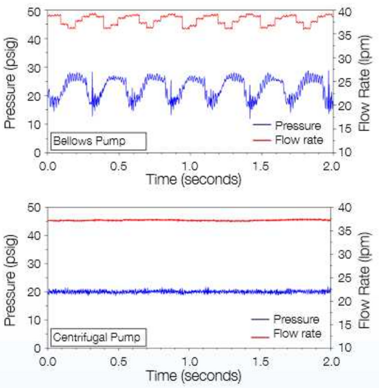Flow-Pressure Curves for other pump types
There are many different types of pumps, which base their technology on different physic principles. The most common types of pump in the semiconductor and life science industries are the Air Operated Diaphragm Pumps, Peristaltic pumps, and Piston-Diaphragm pumps. They have in common the fact that they operate with a “positive displacement” principle. What this means, is that they do not provide a continuous transfer of energy to the fluid, but they first “load” an amount of fluid in a chamber, and subsequently discharge it at a higher pressure. These 2 actions are alternated. As a result the energy transfer is not continuous and it generates oscillations in the pressure and flow rate.
Air Operated Pumps (AOP)
AOPs use compressed CDA (Clean Dry Air) to deliver fluid from a low- to a high-pressure branch of a hydraulic setup. Their performance characteristic is therefore a function of the the CDA pressure driving the process. On the characterization chart it is often indicated the air consumption too (the amount of pressurized air needed to drive the pump at every working point).

Peristaltic and Piston Diaphragm Pumps
These kinds of positive displacement pumps ideally act as flow rate sources: since for every cycle they deliver a certain amount of fluid (irrespective of the pressure, as shown in Figure 2), at every rotational speed (in Hz or rpm) corresponds a certain flow rate (see Figures 3 and 4).



Positive displacement pumps usually present a rotation speed limit, which directly affects the maximum flow rate achievable. There is often a minimum speed too, due to the motor limitations. The minimum speed limit defines the minimum flow achievable with the pump.
Positive displacement pumps’ linear characteristic might give the wrong perception that they are easier to regulate. In reality, since they operate in working cycles, their performance fluctuates around the target flow rate (see Figure 5).

Levitronix pumps as ideal pressure sources
While positive displacement pumps ideally act as flow sources, Levitronix centrifugal pumps ideally act as pressure sources. In fact, once a certain rotational speed is selected, the pressure developed is maintained mostly constant in disregard of the flow rate (see Figure 6).

This means that while the pump is running in speed control mode, if suddenly the system is constricted (change in the system load), the pressure in the tubes will not spike up, making the system intrinsically safer and robust against tubes bursts.
There are application cases that take advantage of this principle in the opposite way: in the case of a closed re-circulation line from which multiple taps are subsequently opened and closed (constantly changing the system load curve) the supply pressure remains constant and the flow rate is automatically adapted, without having to change the pump set-point (see the lesson regarding the Cross-Chamber Talking for detailed information). As a result the various Points of Use will obtain the needed flow rate at the defined pressure.